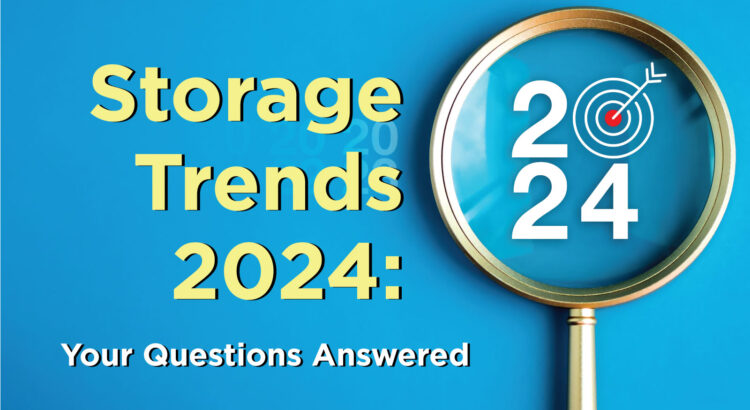At our recent SNIA SCSI Trade Association Forum webinar, “Storage Trends 2024” our industry experts discussed new storage trends developing in the coming year, the applications and other factors driving these trends, and shared market data that illustrated the assertions. If you missed the live event, you can watch it on-demand in the SNIA Educational Library. Questions from the audience ranged from projections about the split between on-prem vs public cloud to queries about different technologies and terms such as NVMe, LTO tape, EDSFF and Cyber Storage. Here are answers to the audience’s questions.
Author: STA Forum
Connector and Cable differences: SAS-3 vs. SAS-4
By: David Einhorn, SCSI Trade Association Board of Directors; Business Development Manager, North America, Amphenol Corp., June 14, 2022
This blog post examines the differences between SAS-3 and SAS-4 connectors and cables. With the new generation of SAS, we see multiple upgrades and improvements.
Drive connector
[Note: 24G SAS uses the SAS-4 physical layer, which operates at a baud rate of 22.5Gb/s.]
The 29-position receptacle and plug connectors used in SAS-4 feature: hot-plugging, blind-mating, connector misalignment correction, and a PCB retention mechanism for robust SMT attachment. The connectors are SATA compliant and available across many suppliers in range of vertical and right-angle configurations. Typical applications are consistent with previous generations of server and storage equipment, HDDs, HDD carriers, and SSDs.
Read More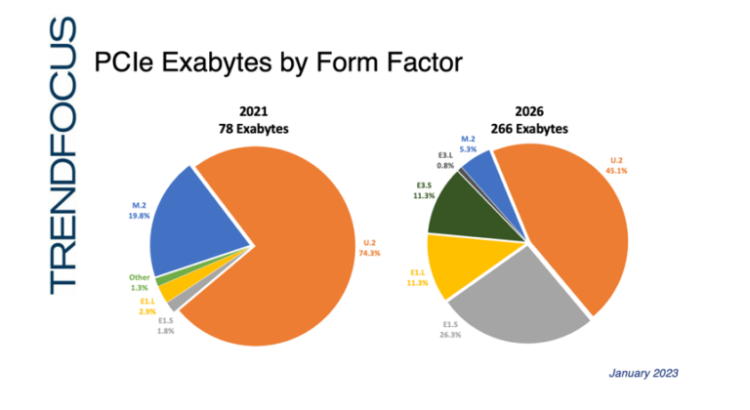
Questions & Answers from our January 2023 Webcast: Storage Trends in 2023 and Beyond
These questions were asked and mostly answered during our webcast, Storage Trends in 2023 and Beyond. Graphics included in this article were shown during the webcast, and several of the questions refer to the data in the charts.
Thank you to our panelists:
Don Jeanette, Vice President, TRENDFOCUS
Patrick Kennedy, Principal Analyst, ServeTheHome
Rick Kutcipal, At-Large Director, SCSI Trade Association and Product Planner, Data Center Solutions Group, Broadcom
Q1: What does the future hold for U.3? (SFF-TA-1001) Was it included in the U.2 numbers?
U.2 should be U.X in the pie chart. There are some shipments out there today, customers are taking it, and it will likely grow — but all the efforts and priorities are really E3S, E1S and then, to some extent, E1,L.
Read More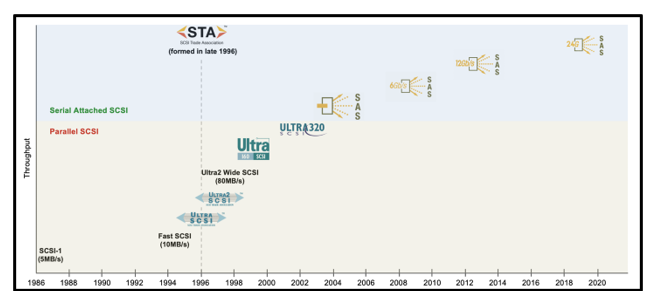
24G SAS: an Overview of the Technology & Products
Hyperscale and enterprise data centers continue to grow rapidly and to use SAS products as a backbone. Why SAS, and what specific SAS products are helping these data centers to grow? This article briefly discusses the technology evolution of SAS, bringing us to our latest generation of 24G SAS. We will examine recent market data from TRENDFOCUS, underscoring the established and growing trajectory of SAS products. We will highlight our latest plugfest, which smoothed the way for 24G SAS to seamlessly enter the existing data storage ecosystem. Finally, we will help the reader to understand the availability, breadth, and depth of 24G SAS products that are available today, and where you can get those products.
Read More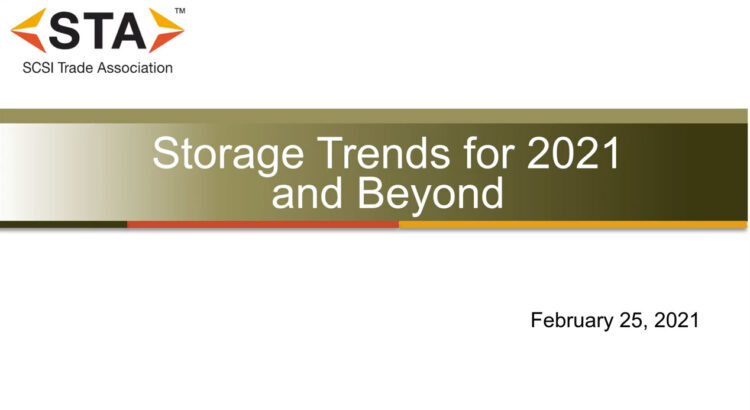
Q&A (Part 1) from “Storage Trends for 2021 and Beyond” Webcast
Questions from “Storage Trends for 2021 and Beyond” Webcast Answered
It was a great pleasure for Rick Kutcipal, board director, SCSI Trade Association (STA), to welcome Jeff Janukowicz, Research vice president at IDC and Chris Preimesberger, former editor-in-chief of eWeek, in a roundtable talk to discuss prominent data storage technologies shaping the market. If you missed this webcast titled “Storage Trends for 2021 and Beyond,” it’s now available on demand here.
The well-attended event generated a lot of questions! So many in fact, we’re authoring a two-part blog series with the answers. In part one, we recap the questions that were asked and answered during the webcast, but since we ran out of time to answer them all, please watch for part two when we tackle the rest.
Q&A from “SAS 201: An Introduction to Enterprise Features” Webcast
Questions from SAS 201 Webinar Answered
In an effort to provide ongoing educational content to the industry, the SCSI Trade Association (STA) tackled the basics of Serial Attached SCSI (SAS) in a webinar titled “SAS 201: An Introduction to Enterprise Features,” now available on the STA YouTube channel here.
Immediately following their presentations, our experts Rick Kutcipal of Broadcom and Tim Symons of Microchip Technology held a Q&A session. In this blog, we’ve captured the questions asked and answers given to provide you with insight on the recent evolutions in SAS enterprise features including 24G SAS and what they mean to system designers.
Q1. Do you think 24G SAS will only be applicable to SSDs, and HDDs will remain at 12Gb/s?
A1. Rick: At this time, hard disk drives (HDDs) can’t take advantage of the bandwidth that’s available in 24G SAS. And right now, the technology itself is focused on the backbone and then solid-state drive (SSD) connectivity. Currently, that’s the way we see it shaping up. Read More
Q&A from “SAS 101: The Most Widely-Deployed Storage Interface” Webcast
Questions from SAS 101 Webcast Answered
In an effort to provide ongoing educational content to the industry, the SCSI Trade Association (STA) tackled the basics of Serial Attached SCSI (SAS) in a webinar titled “SAS 101: The Most Widely-Deployed Storage Interface,” now available on demand here.
Immediately following their presentations, our experts Jeremiah Tussey of Microchip Technology and current STA Vice President; and former STA board member Jeff Mason of TE Connectivity, held a Q&A session. In this blog, we’ve captured the questions asked and answers given to provide you with the extra insight needed on why SAS remains the protocol of choice in the data center. Read More
24G SAS Feature Focus: Inherent Scalability and Flexibility
[Editor’s Note: This is part of a series of blog posts discussing 24G SAS features.]
By: Jeremiah Tussey, Vice President, SCSI Trade Association; Alliances Manager, Product Marketing, Data Center Solutions, Microchip Technology, December 12, 2019
Serial Attached SCSI (SAS) and the SCSI protocol are undergoing an evolution, transitioning to 24G SAS and implementing new features and enhancements to a well-established storage technology. SAS has set the bar in the storage industry with inherent scalability and flexibility in modern data center, server and storage topologies. This tested ability carries forward to the latest update in the SAS technology roadmap: 24G SAS.
Unsurpassed scalability
SAS technology addresses a very large and continuously growing market, natively supporting many host connections to thousands of target devices in a single topology. It enables optimized capacity storage solutions and provides interconnect distance that empowers SAS fabric solutions. Today, SAS services cold cloud data centers, high-performance computing and direct server markets. SAS is effectively the persistent storage with flexibility in attached media solutions.
A variety of interconnect solutions support SAS, with copper for short to medium reach, and fiber optics for long reach applications. These cabling options utilize mini SAS-HD and Quad Small Form-Factor Pluggable (QSFP), as well as recent SlimSAS™ and MiniLink definitions added into the latest SAS standard. Additionally, native failover and dual-port features allow multiple domains to be configured and then automatically takeover operations in the case of component failures, broken cable connections or domain failures of any form. These inherent features were built into the protocol with high reliability, availability and scalability (RAS) in mind. Overall, these maintain per-lane performance, data integrity, flexible architectures and a native hot plugging ability to add or remove enterprise servers and storage for decades.
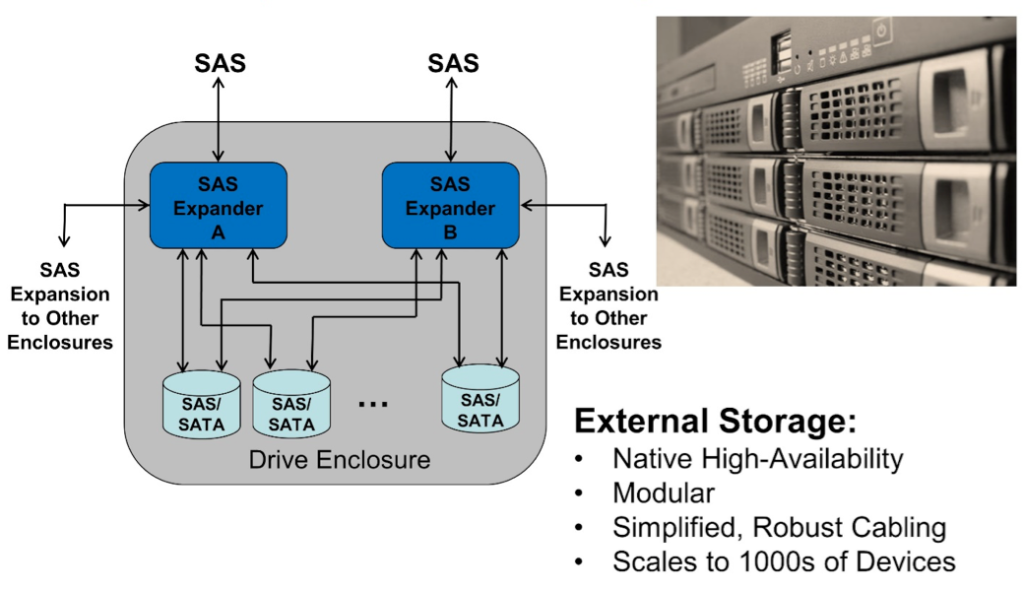
Scalability in External Storage Architectures
Flexibility for the future
What makes this support come all together is the flexibility that is built into SAS. SAS supports simultaneous SAS and SATA end devices, using the Serial SCSI Protocol (SSP) for SAS connections and Serial ATA Tunneling Protocol (STP)for SATA connections. Because SAS technology can support two transport protocols simultaneously, SAS has and will continue to span all storage types. This flexibility allows high-performance SAS SSDs with MultiLink connections for optimized throughput in demanding applications with SAS infrastructure.
Traditional enterprise SAS Hard Disk Drives (HDDs) are still effectively utilized in more practical medium IO-intensive, cost-sensitive applications. With rising use of cost-optimized SAS or SATA SSD alternatives, SSDs are increasingly used in these more IO-Intensive and cost-sensitive applications. SAS has effortlessly enabled that media transition as well. Better yet, SAS enables data centers that are filled with capacity-optimized SAS and SATA HDDs, which still maintain a nearly 10 times cost advantage over NAND Flash-based solutions.
New standards and technology enhancements have been introduced in HDDs to continue supporting the exponential growth in storage demands that cannot be effectively covered with SSD solutions. SMR and hybrid HDD solutions with dynamic configuration only available as a SCSI feature are recent introductions ideal for these capacity-demanding applications. Last but not least, SAS topologies still support backup technologies such as SAS or SATA Tape products, allowing access to historical data storage and continued use of the latest backup solutions based on tape, DVD or Blu-ray backup storage arrays, even in new 24G storage deployments.
SAS Innovations in HDD and SSD Technologies
- SSHD (Solid State Hard Drive) – hybridization of performance and capacity
- Storage Intelligence – SSD optimization, including garbage collection
- TDMR (Two-Dimensional Magnetic Recording) – faster writes
- Helium – capacity optimization
- SMR (Shingled Magnetic Recording) – capacity optimization
- MultiLink – bandwidth
- Multiple Actuator – IOPs per TB
- MAMR (Microwave-Assisted Magnetic Recording) – capacity optimization
- HAMR (Heat-Assisted Magnetic Recording) – capacity optimization
- Hybrid SMR – Configurable SMR vs. standard capacity; helps with SKU management
The ecosystem is on track for 24G SAS production readiness for the upcoming deployment of next-generation server platforms. Analyzers and test equipment have been available for some time now, with cables and connectors in existing and new form-factors ready for 24G SAS. Next-gen SAS controller and expander products are aligned with upcoming PCIe Gen4 platform launches. New 12G SAS and 6G SATA HDD/SSD capabilities to intersect with 24G SAS ecosystem include: MultiLink SAS™ SSDs and Dual-actuator HDDs for increased IOPs/Bandwidth, hybrid SMR for flexible and increased capacity, as well as HAMR / MAMR technologies for increased capacity. SAS continues to evolve through innovation, targeting enhanced performance and features and continuing inherent scalability and flexibility support in modern data center server and storage topologies.
 SAS – Preserving the Past, Creating the Future
SAS – Preserving the Past, Creating the FutureSAS Lives On and Here’s Why
By: Rohit Gupta, Enterprise Segment Management, Western Digital
In the Zettabyte Age, data is the new lifeline. Data is transforming anything and everything at an unprecedented rate in the globally connected world. Businesses are constantly looking for new ways of collecting, storing, and transforming various forms of data to extract intelligence for better decisions, improve processes and efficiencies, develop technologies and innovative products, and ultimately maximize business profitability. Read More
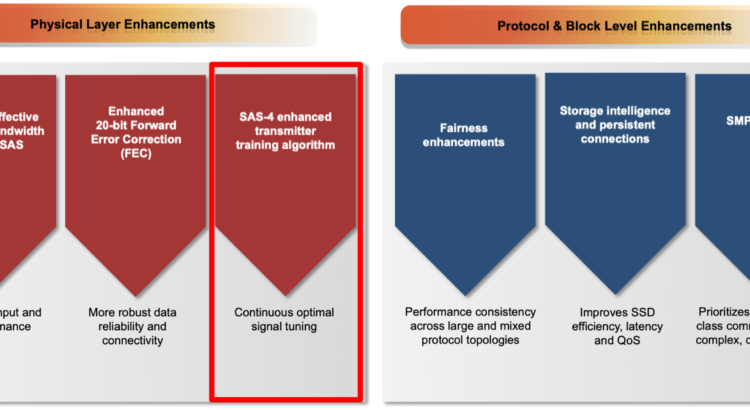
24G SAS Feature Focus: Active PHY Transmitter Adjustment
[Editor’s Note: This is part of a series of upcoming blog posts discussing 24G SAS features.]
By: Rick Kutcipal (SCSI Trade Association), with contributions from Tim Symons (Microchip), November 12, 2019
The first 24G SAS plugfest was held the week of June 24, 2019, and products are expected to begin to trickle out into the marketplace in 2020. Production solutions typically follow 12-18 months after the first plugfest. These storage technologies are tied to OEM server and storage vendors, which release solutions at a regular annual cadence sometimes tied to next generation Intel or AMD processors. Servers almost always lead the way, as they push the performance envelope and keep pace with faster processors, faster networking and faster storage.
To address the growing performance requirements of modern data centers, 24G SAS doubles the effective bandwidth of the previous SAS generation, 12Gb/s SAS. To achieve this bandwidth, the physical layer experiences significant electrical demands that technologies such as forward error correction and Active PHY Transmitter Adjustment (APTA) specifically address. These enhancements are required to maintain the rigorous quality and reliability demands of IT professionals managing enterprise and data center operations. Read More
